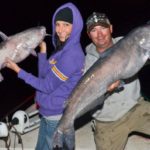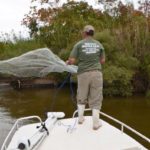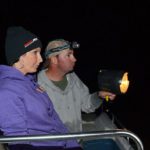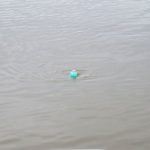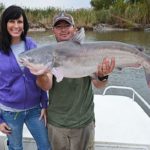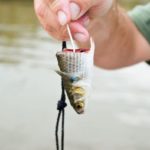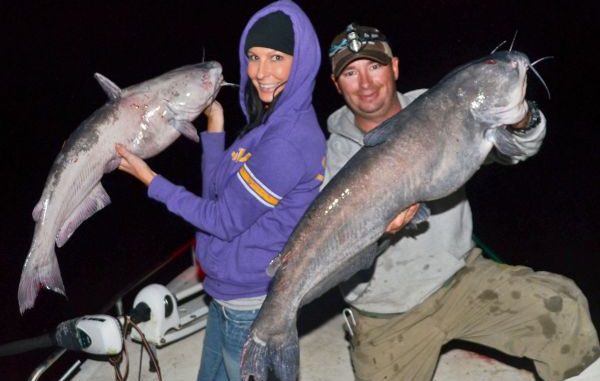
Jug fishing has gone uptown, and this Abbeville couple really have things figured out. Learn how they fill their boat with tasty catfish by making nighttime fishing runs.
They say it’s not bragging if you can do it.
Derek Logan, a 31-year-old Louisiana Department of Wildlife and Fisheries game warden, will tell you exactly what he can do. The fact that he often does it with a sly smirk on his face can make his message challenging.
I quickly found out that he could back up his words about his cooking (Click here to see some of his favorite recipes).
He had also told me that one of his great outdoors passions was fishing jug lines at night for big blue catfish.
And, typical for him, he told me he was very good at it.
So I went to Abbeville to find out. I found him, along with his wife and regular fishing partner Rebecca, cutting bait from his freezer behind the house, prepping for the night’s trip. The bream he had cast-netted from a private pond. The cocahoe minnows came from the marsh.
Interestingly, they were cutting a sizable chunk of the tail off each baitfish and discarding it. Derek caught me eyeing their practice and explained.
“I don’t use the tails,” he said. “There is no blood in them.”
I had never heard that one before.
The frozen bait was more a back-up than anything, just in case we weren’t able to catch any fresh shad and mullet.
“I like to go at night,” he cooed while he worked. “Less thieves (who steal your jugs), less crabs (which steal your bait) and less hardheads (no explanation necessary).
“It’s always nice at night. Nobody around. No one bothering you.”
Rebecca grinned and added her 2 cents.
“I like to fish anytime, day or night,” she said. “Jug fishing is more relaxing than fishing with a rod and reel.
“But the dynamic on the water at night is different.”
Jug fishing Logan-style is best from November to October, when marsh waters are fresher, Derek explained. With cold fronts, catfish come out of the shallows of the marshes and move into deep bayous to feed.
And the salt water in the bayous “cleans the fish up,” he claimed, and they taste much better than when they are in the marsh.
Their main target, blue catfish, is a freshwater species that can tolerate and even thrive in brackish water.
But there are limits.
Recent prevalent south winds had pushed too much saltwater into the Intracoastal Canal between Boston and Oaks canals, where the Logans prefer to fish. On this night they would be fishing the Humble Canal-Freshwater Bayou Gulf Outlet area.
The lengthening evening shadows of winter found us at a small water-control structure, with Rebecca at the helm and Derek up on the bow deck readying his cast net.
Swoosh, he dropped the net in a perfect arc in front of the small wooden structure.
While the net sank, he shared a caution over his shoulder.
“Be sure to tell your readers that many of the canals in the area of Vermilion Parish are posted as private by the Vermilion Corporation,” Derek said.
The net came up full of fish that he dumped on the deck.
Derek danced a little jig, singing “We’re in the money; we’re in the money.”
A couple more throws yielded similar results.
The couple quickly went to work. Threadfin shad, larger gizzard shad, striped mullet and small catfish went into the bait bucket.
A hefty redfish and two good-eating size black drum were chunked back overboard without ceremony.
They were ready to fish.
At the intersection of Freshwater Bayou and Humble Canal, Derek probed water depth with his gaff. He was looking for depths of 3 to 4 feet.
Finding what he liked, he began to bait the hooks of five jugs.
His hands were slightly shaking.
“My heart is pounding so,” he confessed. “I love this. It’s my favorite thing I do. You never know what you are going to pull up.”
These jugs set, he traveled north in Freshwater Bayou a couple of miles, and then stopped to set five more jugs on the bayou’s west bank near some shoreline riprap.
They worked as a team. As Derek ran the boat and probed water depths, Rebecca removed the jug lines from their plastic tote and unwound the lines.
The latest line of jug lines set, the couple moved to drop five more jugs at the intersection of a canal with the bayou.
“I want to see where the fish are,” was Derek’s explanation for moving and setting the jug lines in small groups.
He baited the lines with a variety of baits. Large shad and mullet and catfish were cut into chunks. Small mullet were hooked whole, and smaller shad were hooked three at a time per hook. Some hooks were also baited with the frozen bait, the cut bream and the cocahoes.
They turned and ran back south to set more jugs. As they passed the jugs set along the riprap one of them was “flagged up,” as Derek called it.
I got to see just how neat the jugs worked.
As Derek had set the jug earlier, he jiggled the freely moving piece of rebar in the PVC pipe to the end with the noodle on it, opposite the end to which the line is tied. With the rebar in the correct position, the jug floated on its side.
When a fish grabbed the baited hook, its tug tipped the PVC pipe enough for the rebar to slide to that end.
A flagged-up jug rides vertically in the water, rather than horizontally. This saves the fisherman a lot of time, as only flagged up jugs need to be checked for rebaiting each run.
This catfish was only 3 pounds, but in the next group of jugs one of them clearly held a larger fish.
The jug surged out of Rebecca’s grasp twice. She finally grabbed it and heaved upward with both hands.
A huge, slate-grey head the size of a garden shovel popped to the surface, and the fish began to flounce wildly.
“Drop it! Drop it!” Derek shouted. “Let me get the net.”
He slammed the big landing net under the 25-pound blue cat and wrestled it aboard.
“Hoo-hoo, hoo-hoo — I love it,” he howled.
Rebecca — the strong, silent type — simply smiled sweetly.
It still wasn’t dark, when the fishing gets best, but the bite clearly was on, so Derek and Rebecca baited and set their remaining 22 jug lines in groups of four to six.
One group was put in the Humble Canal and the rest in Freshwater Bayou.
Jugs were never tossed into the water, but rather were gently dropped. The effort was to keep the piece of rebar in the end of the PVC pipe that had the noodle on it and allow the jug to float horizontally.
The pair alternated running the boat and working the front deck. In his excitement, Derek gave lots of instructions when Rebecca was at the wheel.
Finally, feeling that she had been helped enough, she spoke up.
“Derek, you think this is my first time to drive?” Rebecca said.
He flipped his small headlight off and looked back at her and replied, “No, my love.”
Thereafter, his excited stream of commands was punctuated often with “my love.”
She could only grin.
Darkness closed in on them as they ran from jug set to jug set. Quite a few of the jug lines had fish on them.
By 6:30 p.m., they had 10 catfish in the boat, all of them under 10 pounds except for the monster caught before dark.
But it wasn’t all unhook-and-rebait. The jugs took constant minding. Two of them in two different places in Freshwater Bayou ended up 3 or 4 feet up on the riprap, likely dragged there by hungry otters looking to make a meal of the lines’ baits.
At 6:45 p.m., one jug simply disappeared. Derek broke out his ultra high-wattage Q-beam, which he called “the light of the world,” to no avail.
“That’s our lone casualty so far,” he said, shrugging philosophically.
At the next set of jugs, one was way out of place.
“Hoo-hoo; I got a good feeling,” Derek hooted.
Again, Rebecca was in the bow and, again, the jug eluded her grasp. Derek made three passes with the boat before she was able to grab it.
He ran forward immediately with his big landing net.
“Yi, yi, yi, yee!” he shouted in delight as he hauled in a 20-pounder. “I’m a meat hunter and meat fishermen. I’m a country boy, and I like to cook. I give so much fish away commercial fishermen probably hate me. No showboat — just meat!”
“If you can do it, it ain’t bragging,” I remind myself.
And the best action was yet to come.
They moved the next four jugs to the opposite side of the bayou; the jugs hadn’t caught a fish or even had a bite.
As Derek promised, not another boat was on the water except for the occasional tugboat growling up or down the bayou, lighted up like a Christmas tree.
At 7 p.m., with 14 fish in the boat, they ran into the Humble Canal to check its jugs.
Two of the first four held fish — a beautiful 12-pound cat and a smaller but still nice 4-pounder.
The fifth jug had the biggest fish of the night so far on it — nearly 30 pounds.
Derek, already excited, became even more so when the beast broke through the bottom of his landing net.
It was 7:30 p.m. and the first 17 fish filled up one of the two huge tubs the couple had brought to hold their catch.
A run back to check the very first set immediately produced a 2-pounder. It looked puny beside the monsters they have been catching.
Two jugs later a 4-pound blue cat came over the rail. That made 19 fish.
A jug in another group of sets in the bayou held a surprise — a chunky redfish that quickly pulled itself off the hook.
“Good,” Rebecca said.
“Yeah, we don’t want that,” Derek added.
The next jug held another 20-pound blue cat.
It was becoming a slaughter.
The cut fresh mullet was really the ticket. Earlier Derek had expressed concern because his frozen bait had no fishy smell.
“Bait has to smell to be good,” he explained. “I’ve heard of people soaking hot dog halves in Worcestershire sauce and garlic powder to make a smelly bait.”
At 8:05 another redfish popped up, and Derek immediately released in spite of it being a legal catch.
“They taste fishy,” Rebecca murmured.
I could imagine her nose wrinkling in the dark.
Fish No. 21 was a 2-pounder. The rig’s sinker was hung in the rocks, and they had to cut it loose.
They decided to begin picking up their jugs. The next one was empty, but the following two were both flagged up.
The first held a big fish, and this time Derek was on the bow. They had to make four passes before snagging the jug.
But Derek didn’t forget his manners lesson.
“Slow the boat down — my love,” he coached. “Turn the boat this way — my love. Left, left, left — my love.”
With no landing net, Derek had to gaff the fish, which he finally did — and the bigg fish of the night was hauled aboard.
It was odd. Even after all these big fish, every time this fish plunged the jug underwater, I could feel the adrenaline pulse into my veins.
The next jug produced what would be the night’s second-smallest catfish, barely breaking 1 pound.
Then came 10 empties in a row, followed by a flagged-up jug. Something had grabbed the bait and broken the sturdy hook.
The last jug in the group produced an itty-bitty blue cat that likely wouldn’t make a pound on the scale.
As Derek passed the area of the lost jug, he began fretting about its disappearance. Suddenly, almost a mile away, in the light of his Q-beam there was the lost jug — merrily bobbing away.
The 10-plus pound fish was No. 25 for the night.
A couple of jugs later, a 4-pound-or-so fish joined his brothers in the tub. The numbers were all beginning to run together.
Too quickly, it seemed, we picked up the last jug, fittingly with a catfish almost a duplicate of the one before it.
No. 27!
Derek turned his Q-beam off for the moonlit run back to the landing. It was nippy, and Rebecca nestled in beside him on the seat. He turned to her and in a low voice murmured into her hair.
“Not bad for 3 hours of fishing, huh?” he said.
